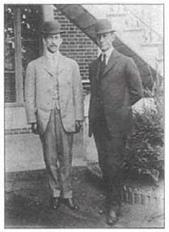The Bishop’s Boys: Wilbur and Orville Wright
|
|
|
|
At the turn of the twentieth century, flying was about to take a giant step forward. As we saw in the last chapter, the science of flight began to take off in the last few years of the 1700s, when daring experimenters pushed the boundaries of ballooning by flying to higher and higher altitudes. In the late 1800s, some even attached early internal combustion motors to the balloons to create a sort of early blimp.
In the late 1800s, groups of pioneers began to do their own experimenting by strapping homemade wings to their backs and soaring off cliffs. These first bird-men, building better and better gliders, paved the way for a new breed of flyer that was about to emerge. The early glider pilots worked mostly in Europe, but something was brewing in Dayton, Ohio, that would give a couple of restless Midwest boys their own chapter in history.
The Bishop’s Boys
In 1878, Reverend Milton Wright brought home a little rubber band-powered toy for his sons Wilbur and Orville. Wilbur, who was 11 at the time, and Orville, who was 7, took turns winding it up and sending it flying off around the room. The toy, which resembled a helicopter, was delicate and it wasn’t long before it was damaged beyond repair. But those few hours the boys spent flying a toy around their house was enough to set them off on a career that led to man’s first heavier-than – air flight.
Later, the brothers dropped out of high school and started a couple of businesses that made them enough money to support their hobby of building gliders, as other experimenters were doing. Eventually, they started fiddling around with an engine, propellers, and the complicated systems that would enable them not to glide, but fly.
The Race to Fly
|
Turbulence Toy makers were delighting children with helicopter-like flying toys long before the Wright brothers came along—but don’t be fooled into thinking that the helicopter was invented before the airplane. The first American helicopter didn’t fly until 1939. |
The brothers read everything they could lay their hands on about other would-be flyers and the glider experiments going on in Europe and America. They were latecomers in a race that seemed to be already out of their reach. But the bicycle makers from Dayton had a personal chemistry that enabled them to catch up with and then surpass their competitors.
Still, when Wilbur and Orville finally made history’s first sustained, controlled flight in December 1903, the event was almost anticlimactic. Just look at the setting where the pivotal technological feat of the first half of the century took place: a deserted, windblown beach on the North Carolina coast, where the brothers worked in near isolation.
This kind of roughing-it aviation had a whole different flavor from what was going on then in Europe. On the Continent, would-be flyers gathered in clubs and salons to hear lectures while they sipped wine and cordials. And while some members of the European intelligentsia debated whether controlled, heavier-than-air flight was even possible, the Wrights tinkered with their hand-built engine and sanded their selfdesigned propellers in that drafty shack on Kill Devil Hill.
The somewhat primitive conditions the Wrights chose to do their research and conduct their early flights in are deceptive: What Wilbur and Orville did on that sandblown beach was years ahead of its time. In fact, although the Wrights would continue to refine and improve their planes as soon as they finished their first powered flight, it wasn’t until 1906 that anyone else was able to make even as small a flight as the brothers’ initial 12- second hop. And it took even longer for another American to match the feat. Glenn Curtiss managed to fly his June Bug in 1908; by which time the Wrights had already flown hundreds of times in trips of dozens of miles at a time. While major technological breakthroughs typically inspire wild flurries of imitations and discoveries, the Wrights’ flight was so advanced that the brothers had no competitors for years.
|
The Wright brothers, Orville (left) and Wilbur, were inseparable for most of their lives.‘ They were in a number of businesses together, including the airplane and engine company that made them rich. |















